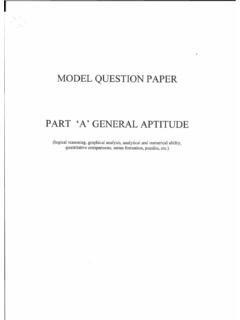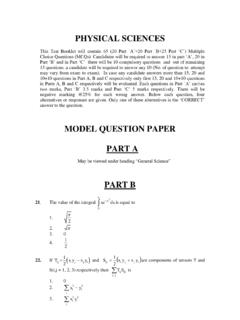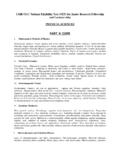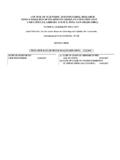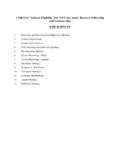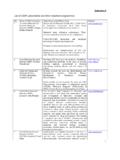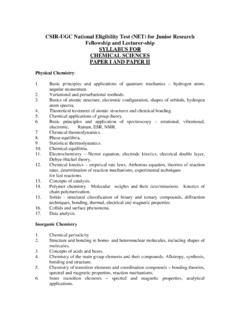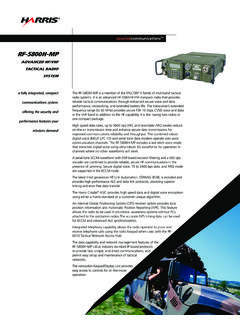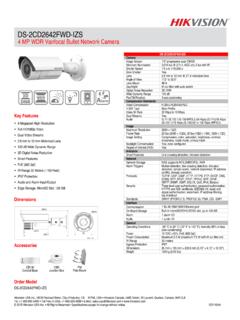Transcription of MATHEMATICAL SCIENCES - CSIR
1 MATHEMATICAL SCIENCES This Test Booklet will contain 120 (20 Part `A +40 Part `B+60 Part C ) Multiple Choice Questions (MCQs) Both in Hindi and English. Candidates are required to answer 15 in part A , 25 in Part B and 20 questions in Part C respectively (No. of questions to attempt may vary from exam to exam). In case any candidate answers more than 15, 25 and 20 questions in Part A, B and C respectively only first 15, 25 and 20 questions in Parts A, B and C respectively will be evaluated. Each questions in Parts `A carries two marks, Part B three marks and Part C marks respectively.
2 There will be negative marking marks in Part A and in part B for each wrong answers. Below each question in Part A and Part B , four alternatives or responses are given. Only one of these alternatives is the CORRECT answer to the question. Part C shall have one or more correct options. Credit in a question shall be given only on identification of ALL the correct options in Part C . No credit shall be allowed in a question if any incorrect option is marked as correct answer. No partial credit is allowed. MODEL QUESTION PAPER PART A May be viewed under heading General Science PART B 21.
3 The sequence an = (1)(2 )nnn 1 converges to 0 2 converges to 1/2 3 converges to 1/4 4 does not converge. 22. Let xn = n 1/n and yn = (n!)1/n , n 1 be two sequences of real numbers. Then 1 (xn) converges, but (yn) does not converge 2 (yn) converges, but (xn) does not converge 3 both (xn) and (yn) converge 4 Neither (xn) nor (yn) converges 23. The set { x : x sin x 1 , x cos x 1 } is 1 a bounded closed set 2 a bounded open set 3 an unbounded closed set. 4 an unbounded open set. 24. Let f:[0,1] be continuous such that f(t) 0 for all t in [0, 1]. Define g(x) =0()xf t dt then 1 g is monotone and bounded 2 g is monotone, but not bounded 3 g is bounded, but not monotone 4 g is neither monotone nor bounded 25.
4 Let f be a continuous function on [0, 1] with f(0) =1. Let G(a) = 01()af x dxa 1 01lim ( )2aGa 2 0lim ( )aGa 1 3 0lim ( )aGa 0 4 The limit 0lim ( )aGa dose not exist 26. Let n = sin (21n) , n = 1,2, .. Then 1 1nn converges 2 lim suplim infnnnn 3 lim1nn 4 1nn diverges 27. If, for x , (x) denotes the integer closest to x (if there are two such integers take the larger one), then 1210()x dx equals 1 22 2 11 3 20 4 12 28. Let P be a polynomial of degree k > 0 with a non-zero constant term. Let fn(x) = P(xn) x (0, ) 1 lim( )nnfx x (0, ) 2 x (0, ) such that lim( )nnfx > P(0) 3 lim( )nnfx =0 x (0, ) 4 lim( )nnfx = P(0) x (0, ) 29.
5 Let C [0, 1] denote the space of all continuous functions with supremum norm. Then, 1 [0,1] : lim0nKffn = = is a 1. vector space but not closed in C[0,1]. 2. closed but does not form a vector space. 3. a closed vector space but not an algebra. 4. a closed algebra. 30. Let u, v, w be three points in 3 not lying in any plane containing the origin. Then 1 1 u + 2 v + 3 w = 0 => 1 = 2 = 3 = 0 2 u, v, w are mutually orthogonal 3 one of u, v, w has to be zero 4 u, v , w cannot be pairwise orthogonal 31. Let x, y be linearly independent vectors in 2 suppose T: 2 2 is a linear transformation such that Ty = x and Tx =0 Then with respect to some basis in 2 , T is of the form 1 00aa , a > 0 2 00ab , a , b > 0; a b 3 0100 4 0000 32.
6 Suppose A is an n x n real symmetric matrix with eigenvalues 12,,..,n then 1 1det( )niiA 2 1det( )niiA 3 1det( )niiA 4 det( ) 1ifA then 1j for j =1, .. n. 33. Let f be analytic on D = { z : |z | < 1} and f(0) =0 . Define ();0()(0);0fzzgzzfz Then 1 g is discontinuous at z = 0 for all f 2 g is continuous, but not analytic at z = 0 for all f 3 g is analytic at z = 0 for all f 4 g is analytic at z = 0 only if f ' (0) = 0 34. Let be a domain and let f(z) be an analytic function on such that |f(z)| = | sin z | for all z then 1 f(z) = sin z for all z 2 f(z) = sin z for all z.
7 3 there is a constant c with |c| = 1 such that f(z) = c sin z for all z 4 such a function f(z) does not exist 35. The radius of convergence of the power series 430(43)nnn zn is 1 0 2 1 3 5 4 36. Let be a finite field such that for every a the equation x2 =a has a solution in . Then 1 the characteristic of must be 2 2 must have a square number of elements 3 the order of is a power of 3 4 must be a field with prime number of elements 37. Let be a field with 512 elements. What is the total number of proper subfields of ? 1 3 2 6 3 8 4 5 38. Let K be an extension of the field Q of rational numbers 1 If K is a finite extension then it is an algebraic extension 2 If K is an algebraic extension then it must be a finite extension 3 If K is an algebraic extension then it must be an infinite extension 4 If K is a finite extension then it need not be an algebraic extension 39.
8 Consider the group S9 of all the permutations on a set with 9 elements. What is the largest order of a permutation in S9 ? 1 21 2 20 3 30 4 14 40. Suppose V is a real vector space of dimension 3. Then the number of pairs of linearly independent vectors in V is 1 one 2 infinity 3 e3 4 3 41. Consider the differential equation 2, ( , )dyyx ydx . Then, 1. all solutions of the differential equation are defined on ( , ). 2. no solution of the differential equation is defined on ( , ). 3. the solution of the differential equation satisfying the initial condition y(x0) = y0, y0 > 0, is defined on 001,xy.
9 4. the solution of the differential equation satisfying the initial condition y(x0)=y0, y0>0, is defined on 001,xy - . 42. The second order partial differential equation 222221210uuuxyxyxx yy is 1. hyperbolic in the second and the fourth quadrants 2. elliptic in the first and the third quadrants 3. hyperbolic in the second and elliptic in the fourth quadrant 4. hyperbolic in the first and the third quadrants 43. A general solution of the equation ( , )( , )xu x yu x yex- += is 1. ( , )f ( )xu x yey 2. ( , )f ( )xxu x yeyxe 3. ( , )f ( )xxu x yeyxe 4. ( , )f ( )xxu x yeyxe 44.
10 Consider the application of Trapezoidal and Simpson s rules to the following integral 4320(2351)xxxdx 1. Both Trapezoidal and Simpson s rules will give results with same accuracy. 2. The Simpson s rule will give more accuracy than the Trapezoidal rule but less accurate than the exact result. 3. The Simpson s rule will give the exact result. 4. Both Trapezoidal rule and Simpson s rule will give the exact results. 45. The integral equation g(x)y(x)=f(x)+ k(x,t)y(t)dt with f(x), g(x) and k(x,t) as known functions, and as known constants, and as a known parameter, is a 1. linear integral equation of Volterra type 2.
